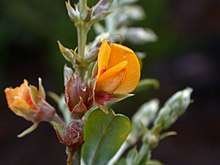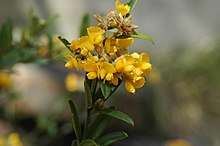Oxylobium ellipticum
Oxylobium ellipticum, known as the Common Shaggy-pea is a common small plant in the pea family, found in south-eastern Australia.[1]

| Oxylobium ellipticum | |
|---|---|
 | |
| Common Shaggy-pea | |
| Scientific classification | |
| Kingdom: | |
| (unranked): | |
| (unranked): | |
| (unranked): | |
| Order: | |
| Family: | |
| Genus: | |
| Species: | O. ellipticum |
| Binomial name | |
| Oxylobium ellipticum (Vent.) R.Br. | |
Description
Oxylobium ellipticum is spreading much branched shrub can grow above 2m tall. Leaves are elliptical to 4 cm long, leathery, brown tomentose beneath, dark green, reticulate veins and margins recurved, apex blunt, often with an abrupt point. It has golden yellow pea flowers in dense terminal clusters. Pods 7–8 mm long, rounded, grey-brown, covered with the long silky hairs. Flowering usually take place between the September and January.[2]
Habitat
Soil
Grows frequently on the skeletal soils and organic brown peat on quartzite sand.[2]
Distribution
Oxylobium ellipticum is endemic to Australia,[2] mostly widespread in Tasmania, Victoria, New South Wales and Queensland.[2]
Research Article
This research is about the molecular phylogeny study between the species like Oxylobium, Gastrolobium, Brachysema, Jansonia, Nemica and podolobium is presented. The study was conducted using the chloroplast DNA and nuclear ribosomal DNA. Oxylobium is shown to be polyphyletic, while Gastrobium is paraphyletic containing within it the genera Branchysema, Jansonia and Nemcia, as well as Oxylobium lineare. Molecular traits such as ovule number, fluroacetate content and different morphological was studied. The molecular analysis were compared to each other. The results support the recent monograph that expands Gastrolobium to include Jansonia, Nemica, Brachysema and Oxylobium. The revision of the leaves Oxylobium and Podolobium occurring exclusively in eastern Australia, while Gastrolobium occurs almost exclusively in south western Australia, with only two species , G. brevipes and G. grandiflorum, occurring outside the Australia.[3]

References
- "Oxylobium ellipticum, PlantNET - NSW Flora Online". Retrieved 2011-02-18.
- Wapstra,Simmons, Annie,Marion,Hans (2016). A GUIDE TO FLOWERS AND PLANTS OF TASMANIA. Sydney: Martin Ford. p. 64. ISBN 9781877069475.
- CHANDLER, BAYER, GILMO, GREGORY T.,RANDALL J.,SIMON R. (December 2003). "Oxylobium/Gastrolobium (Fabaceae : Mirbelieae) conundrum: further studies using molecular data and a reappraisal of morphological characters". Plant Species Biology. 18: 91–101 – via wiley online library.CS1 maint: multiple names: authors list (link)
| Wikimedia Commons has media related to Oxylobium ellipticum. |